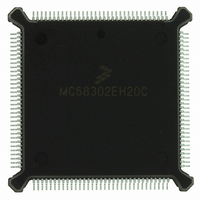MC68302EH20C Freescale Semiconductor, MC68302EH20C Datasheet - Page 359

MC68302EH20C
Manufacturer Part Number
MC68302EH20C
Description
IC MPU MULTI-PROTOCOL 132-PQFP
Manufacturer
Freescale Semiconductor
Datasheets
1.MC68302AG20C.pdf
(4 pages)
2.MC68302AG20C.pdf
(2 pages)
3.MC68302AG20C.pdf
(13 pages)
4.MC68302EH20C.pdf
(481 pages)
Specifications of MC68302EH20C
Processor Type
M683xx 32-Bit
Speed
20MHz
Voltage
5V
Mounting Type
Surface Mount
Package / Case
132-MQFP, 132-PQFP
Family Name
M68000
Device Core
ColdFire
Device Core Size
32b
Frequency (max)
20MHz
Instruction Set Architecture
RISC
Supply Voltage 1 (typ)
5V
Operating Temp Range
0C to 70C
Operating Temperature Classification
Commercial
Mounting
Surface Mount
Pin Count
132
Package Type
PQFP
Lead Free Status / RoHS Status
Lead free / RoHS Compliant
Features
-
Lead Free Status / Rohs Status
Compliant
Available stocks
Company
Part Number
Manufacturer
Quantity
Price
Company:
Part Number:
MC68302EH20C
Manufacturer:
Freescale Semiconductor
Quantity:
10 000
Part Number:
MC68302EH20C
Manufacturer:
FREESCALE
Quantity:
20 000
Company:
Part Number:
MC68302EH20CB1
Manufacturer:
Freescale Semiconductor
Quantity:
10 000
Company:
Part Number:
MC68302EH20CR2
Manufacturer:
Freescale Semiconductor
Quantity:
10 000
- MC68302AG20C PDF datasheet
- MC68302AG20C PDF datasheet #2
- MC68302AG20C PDF datasheet #3
- MC68302EH20C PDF datasheet #4
- Current page: 359 of 481
- Download datasheet (2Mb)
in the buffer or when certain events, such as an error or an end-of-frame, are detected.
Whatever the reason, the buffer is then said to be closed, and additional data will be stored
using the next BD. Whenever the CP needs to begin using a BD because new data is arriv-
ing, it will check the empty bit of that BD. If the current BD is not empty, it will report a busy
error. However, the CP will not move from the current BD until it becomes empty. When the
CP sees the “wrap” bit set in a BD, the CP goes back to the beginning of the BD table after
use of this BD is complete. After using a BD, the CP sets its empty bit to not-empty; thus,
the CP will never use a BD twice. The BD must be processed by the M68000 core before
being used again.
D.3.3 New Pointers
To control the buffering of the SCCs, the three BD pointers to be used by software are de-
fined. Two pointers are used for the transmit BDs, and one pointer is used for the receive
BDs (see Figure D-5).
New transmit data (NTD) shows the next transmit BD that will be receiving data. This is the
first pointer to move in the transmit process.
Confirm transmit data (CTD) shows the next transmit BD that will be confirmed. To confirm
a buffer, check for errors after transmission and then mark the BD as available for USQ. This
is the last pointer to move in the transmit process.
MOTOROLA
TBD#
NTD
CTD
Figure D-5. Pointer during Execution
TRANSMIT BD TABLE
R = 0
R = 0
R = 1
R = 1
R = 0
R = 0
R = 0
R = 0
MC68302 USER’S MANUAL
5
6
7
3
4
0
1
2
IN USE BY SCC
RBD#
PRD
RECEIVE BD TABLE
E = 1
E = 1
E = 0
E = 0
E = 1
E = 1
E = 1
E = 1
5
6
7
0
2
3
4
1
MC68302 Applications
D-9
Related parts for MC68302EH20C
Image
Part Number
Description
Manufacturer
Datasheet
Request
R
Part Number:
Description:
Manufacturer:
Freescale Semiconductor, Inc
Datasheet:

Part Number:
Description:
MC68302 Configuring the Chip Selects on the MC68302
Manufacturer:
Motorola / Freescale Semiconductor

Part Number:
Description:
MC68302 Design Concept - Expanding Interrupts on the MC68302
Manufacturer:
Motorola / Freescale Semiconductor

Part Number:
Description:
MC68302 MC68302 Adapting a WAN Controller to a LAN Environment
Manufacturer:
Motorola / Freescale Semiconductor

Part Number:
Description:
MC68302 EKB Applications - Power Measurements on the MC68302
Manufacturer:
Motorola / Freescale Semiconductor

Part Number:
Description:
MC68302 Interfacing the MC68020 to a Slave MC68302
Manufacturer:
Motorola / Freescale Semiconductor

Part Number:
Description:
MC68302 MC68302 Software Performance
Manufacturer:
Motorola / Freescale Semiconductor

Part Number:
Description:
MC68302 Evaluating EDX on the ADS302
Manufacturer:
Motorola / Freescale Semiconductor

Part Number:
Description:
MC68302 Design Advisory #1 - MC68SC302 Passive ISDN Protocol Engine
Manufacturer:
Motorola / Freescale Semiconductor

Part Number:
Description:
MC68302, MC68360, and MPC860 Characteristics and Design Notes for Crystal Feedback Oscillators
Manufacturer:
Motorola / Freescale Semiconductor
Part Number:
Description:
Mc68302 Integrated Multi-protocol Processor
Manufacturer:
Freescale Semiconductor, Inc
Datasheet:
Part Number:
Description:
Manufacturer:
Freescale Semiconductor, Inc
Datasheet:
Part Number:
Description:
Manufacturer:
Freescale Semiconductor, Inc
Datasheet:
Part Number:
Description:
Manufacturer:
Freescale Semiconductor, Inc
Datasheet:
Part Number:
Description:
Manufacturer:
Freescale Semiconductor, Inc
Datasheet:











